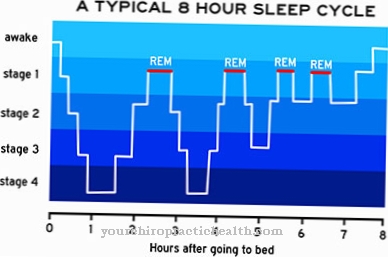As sarcoma is a rare malignant tumor that can affect any part of the body. It is therefore a major medical challenge to identify and treat the disease. It is not uncommon for patients to have traveled a long way through various healthcare units before the correct diagnosis is made. The following applies: the earlier a sarcoma is detected, the better the chances of recovery.
What is a sarcoma?

© peterschreiber.media - stock.adobe.com
A sarcoma is a composite of several degenerate body cells that multiply more than healthy cells. The rapid cell growth of the tumor cells leads to a malfunction of the affected trade or organ.
As a malignant tumor, the sarcoma often detaches from its place of origin and colonizes the surrounding tissue (infiltration) or reaches more distant body tissue via the bloodstream or the lymph system, which leads to the formation of metastases. Sarcomas can be divided into two main groups: soft tissue sarcomas and bone sarcomas.
In the case of soft tissue sarcomas, doctors differentiate between more than 150 different types of tumors that form in connective tissue, adipose tissue or muscles. The disease is most common in adults between the ages of 45 and 55.
Bone sarcomas, which can form in the bones as well as in the bone marrow, in the cartilage or in the joints, are more likely to affect young people between the ages of 10 and 30.
causes
It is largely unclear what factors lead to the development of Sarcomas contribute. Contact with industrial poisons was considered a possible cause until a few years ago, but statistical evidence has not yet been provided.
Sarcomas rarely develop in the irradiated areas of the body after radiation therapy. In connection with certain diseases such as neurofibromatosis, retinoblastoma or Fraumeni's syndrome, the development of soft tissue sarcomas can be observed more frequently.
Congenital genetic defects can also promote the development of different tumors. However, all these factors are only responsible for the development of a very small proportion of sarcomas. Almost all sarcomas occur spontaneously without a specific trigger being identified.
Typical & common sarcomas
- Ewing's sarcoma
- Kaposi's sarcoma
- Osteosarcoma
- Chondrosarcoma
- Fibrosarcoma
- Liposarcoma
- Angiosarcoma
- Leiomyosarcoma
- Rhabdomyosarcoma
Symptoms, ailments & signs
Symptoms differ depending on the type of sarcoma. Soft tissue sarcomas are often painless at the beginning. As the disease progresses, pain can occur due to the increasing size of the tumor. Functional restrictions of the affected structures are also possible. Osteosarcoma, the sarcoma of the bones, also makes itself felt quite late.
One of the first symptoms is local swelling with pain. Just like with soft tissue sarcoma, with osteosarcoma too, displacement can lead to functional restrictions in the joints or other surrounding structures. Localized pain, swelling and overheating are key symptoms of Ewing's sarcoma, a malignant tumor in children and adolescents.
Depending on its size, the sarcoma can displace other structures in the body and thus lead to functional restrictions or loss of functionality. As with most cancers, sarcoma can also have so-called B symptoms. Those affected suffer from unexplained fever and night sweats. The characteristics can be very different.
Some of the patients feel only a slight film of sweat, while other patients soak the bed linen completely with their sweat. Furthermore, people with sarcoma often unintentionally lose more than ten percent of their body weight within six months.
Diagnosis & course
An initially painless swelling that often grows over weeks and months can be the first sign of a sarcoma be. If the tumor continues to spread, thereby stretching important nerves, the affected person often experiences pain.
Furthermore, the functionality of normal tissue is usually limited. In order to diagnose a possible tumor, the oncologist first uses imaging methods such as X-rays, computed tomography and magnetic resonance tomography.A blood test can also provide information about the presence of a sarcoma, as some blood values indirectly indicate its existence.
In order to finally confirm the diagnosis, a sample of the tumor is often taken and examined under a microscope. Since the removal of the tumor cells into the surrounding tissue can spread them into the body, an operation must be performed as soon as possible if the results are positive.
Complications
A sarcoma can cause a variety of complications. If the tumor spreads within the tissue, this can lead to tissue damage and nerve disorders. In the further course of the disease, the sarcoma can spread and spread to other parts of the body and internal organs - the result is a variety of complaints and permanent tissue and organ damage.
At the same time, chronic pain develops, which can lead to psychological problems if the illness lasts longer. For example, many people suffer from anxiety disorders and depression, which often persist for a long time after treatment. Before the operation, there is a risk that the wrong biopsy access will be made.
At the same time, bruises and infections can develop. Vascular injuries and bleeding are conceivable during and after the operation. In addition, the skin at the site of the procedure can scar or lead to wound healing disorders and inflammation. Finally, the prescribed medication can also cause discomfort.
Mostly pain relievers and anti-inflammatory drugs are used, which occasionally cause headaches, muscle and bone pain, problems of the gastrointestinal tract and skin irritations. If the patient suffers from a previous illness, serious complications of the cardiovascular system can arise.
When should you go to the doctor?
A doctor should always treat sarcoma. As a rule, it cannot heal independently, and in the worst case, the person affected can even die without medical treatment. In any case, the further spread of the tumor must be prevented.
A doctor should be consulted if the person concerned suffers from very severe swelling. This swelling can appear in different parts of the body and is usually relatively easy to see with the eye. Often night sweats are also an indication of sarcoma and should be examined by a doctor. Furthermore, there may also be a fever or severe weight loss for the person concerned.
The sarcoma can primarily be diagnosed by a general practitioner. For further treatment, however, a specialist is necessary who can remove the sarcoma. It cannot be universally predicted whether the disease will progress positively. The life expectancy of the person affected may also be reduced by the disease.
Treatment & Therapy
The therapy of a Sarcoma depends crucially on the spread of the disease after the diagnosis is made. For small, localized tumors, surgery is the first choice.
The aim here is to completely remove the malignant tissue. For this purpose, part of the healthy tissue adjacent to the sarcoma is also removed, since tumor cells that have migrated there can hide, which promote the formation of metastases. In the case of large tumors, an attempt is made to reduce the size by chemotherapy before they are removed by surgery.
If metastases have already formed, chemotherapy, which can be administered via tablets, infusion or syringe, is the first treatment step. If this therapy remains ineffective, radiation can help destroy the tumor tissue. More recent studies show that the administration of drugs that block the metabolic pathways in the tumor cell can have a positive effect on the success of the treatment.
Since every patient reacts differently to new substances and drugs for chemotherapy, the creation of an individual therapy plan is an absolute must.
prevention
The making of Sarcomas is not influenced by the behavior of the person affected, which is why there are no preventive measures. A healthy lifestyle, which includes a balanced diet and adequate exercise, as well as taking preventive medical check-ups, is a crucial step in maintaining health. If there is already an illness, a balanced social environment that supports the person affected has a positive influence on recovery.
Aftercare
After the medical treatment of the sarcoma, follow-up care begins. One of their main goals is the timely detection and treatment of a relapse, i.e. a recurrence of the tumor. In addition, follow-up care deals with undesirable consequences or side effects of cancer treatment and helps the patient to get back to everyday life.
If the sarcoma can be surgically removed, regular follow-up examinations must then take place. This also applies if a complete healing can no longer be achieved so that the treatment can be controlled. The check-ups are carried out either by an oncologist or a special tumor center. How often the follow-up examinations have to take place depends on the course of the disease and the individual health of the patient.
As a rule, they are initially carried out every three months. In this way it is possible to take action against possible new tumor formations or sequelae of the treatment at an early stage. In addition, the doctor will check whether metastases (daughter tumors) have formed. However, so far there are no laboratory values, such as blood tests, that could indicate a new sarcoma.
If amputations had to be performed as part of the treatment, the doctor monitors the progress of the rehabilitation measures. A close follow-up of up to five years is recommended by experts. The patient should insist on these check-ups out of self-interest.
You can do that yourself
Patients with a sarcoma are exposed to very special circumstances and situations. They face the circumstance that their life ends prematurely. In the area of self-help, there are hardly enough opportunities to achieve recovery. Nevertheless, the sick person should take various measures to improve their situation in dealing with the disease and its side effects.
With a positive basic attitude towards oneself and towards life, the patient can have a significant influence on the course of the disease. Studies have shown that therapeutic approaches are more effective if the person concerned works together with the doctor and believes in an improvement in their situation. A healthy lifestyle, a balanced diet and mental techniques help to strengthen the immune system and mental strength. In addition, alternative healing methods can have a positive influence on further development.
It is important to promote the joy of life and to make treatment decisions that the person concerned is convinced of. The organization of leisure time is to be geared towards the physical needs and capabilities of the patient. Open discussions about the situation and the development of health help in coping with the disease. The patient and their relatives should be honest with one another and clarify any questions with one another.


.jpg)
























